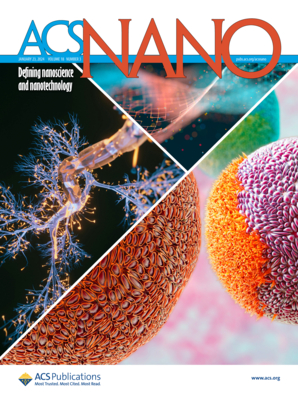Room-Temperature Exciton-Polariton-Driven Self-Phase Modulation in Planar Perovskite Waveguides
IF 15.8
1区 材料科学
Q1 CHEMISTRY, MULTIDISCIPLINARY
引用次数: 0
Abstract
Optical nonlinearities are crucial for advanced photonic technologies since they allow photons to be managed by photons. Exciton-polaritons resulting from strong light–matter coupling are hybrid in nature: they combine the small mass and high coherence of photons with strong nonlinearity enabled by excitons, making them ideal for ultrafast all-optical manipulations. Among the most prospective polaritonic materials are halide perovskites since they require neither cryogenic temperatures nor expensive fabrication techniques. Here, we study strikingly nonlinear self-action of ultrashort polaritonic pulses propagating in planar MAPbBr3 perovskite slab waveguides. Tuning the input pulse energy and central frequency, we experimentally observe various scenarios of its nonlinear evolution in the spectral domain, which include peak shifts, narrowing, or splitting driven by self-phase modulation, group velocity dispersion, and self-steepening. The theoretical model provides complementary temporal traces of pulse propagation and reveals the transition from the birth of a doublet of optical solitons to the formation of a shock wave, both supported by the system. Our results presented here represent an important step in ultrafast nonlinear on-chip polaritonics in perovskite-based systems.

光非线性对于先进的光子技术至关重要,因为它们允许光子管理光子。强光-物质耦合产生的激子-极化子具有混合性质:它们将光子的小质量和高相干性与激子的强非线性结合在一起,是超快全光学操作的理想选择。卤化物过氧化物晶石是最有前景的极光材料之一,因为它们既不需要低温,也不需要昂贵的制造技术。在这里,我们研究了在平面 MAPbBr3 包晶板坯波导中传播的超短极化脉冲的惊人非线性自作用。通过调节输入脉冲的能量和中心频率,我们在实验中观察到其在光谱域中的各种非线性演变情况,其中包括由自相位调制、群速度色散和自膨胀驱动的峰值移动、收窄或分裂。理论模型提供了脉冲传播的互补时间轨迹,并揭示了从双光孤子的诞生到冲击波形成的过渡过程,两者都得到了系统的支持。我们在此展示的结果代表了在基于包晶石的系统中实现超快非线性片上极化的重要一步。
本文章由计算机程序翻译,如有差异,请以英文原文为准。
求助全文
约1分钟内获得全文
求助全文
来源期刊

ACS Nano
工程技术-材料科学:综合
CiteScore
26.00
自引率
4.10%
发文量
1627
审稿时长
1.7 months
期刊介绍:
ACS Nano, published monthly, serves as an international forum for comprehensive articles on nanoscience and nanotechnology research at the intersections of chemistry, biology, materials science, physics, and engineering. The journal fosters communication among scientists in these communities, facilitating collaboration, new research opportunities, and advancements through discoveries. ACS Nano covers synthesis, assembly, characterization, theory, and simulation of nanostructures, nanobiotechnology, nanofabrication, methods and tools for nanoscience and nanotechnology, and self- and directed-assembly. Alongside original research articles, it offers thorough reviews, perspectives on cutting-edge research, and discussions envisioning the future of nanoscience and nanotechnology.
 求助内容:
求助内容: 应助结果提醒方式:
应助结果提醒方式:


